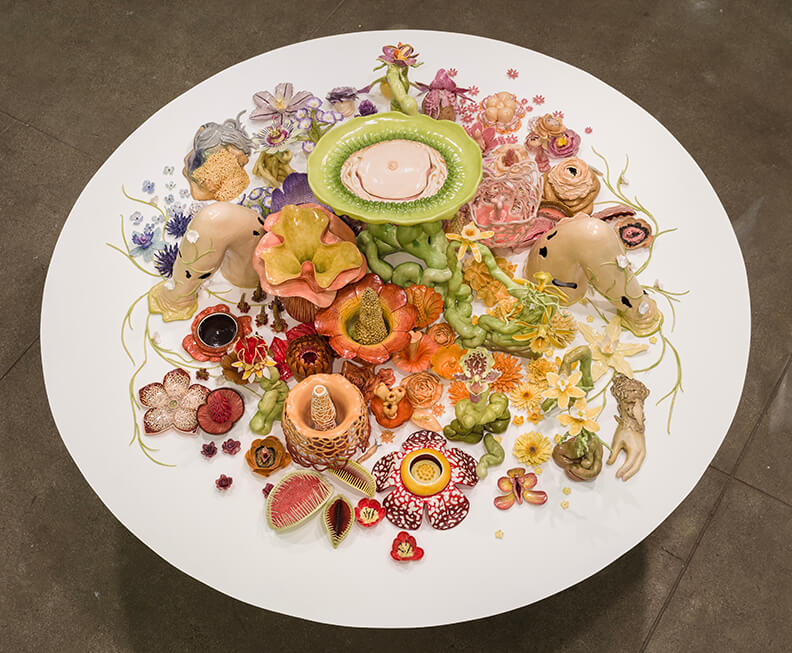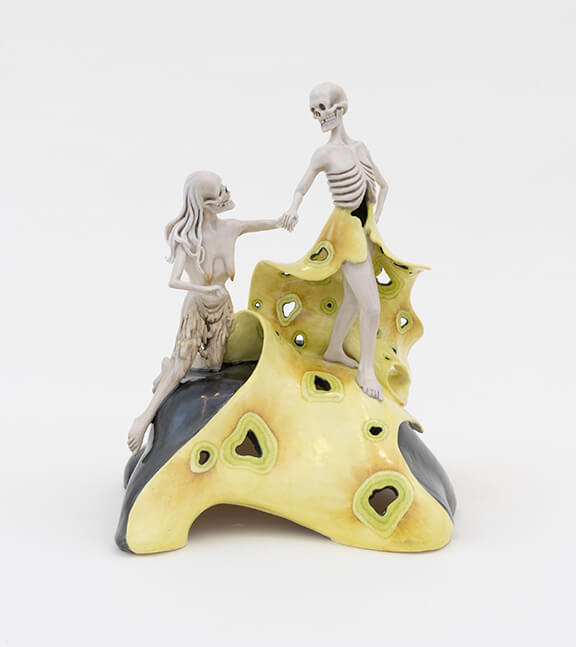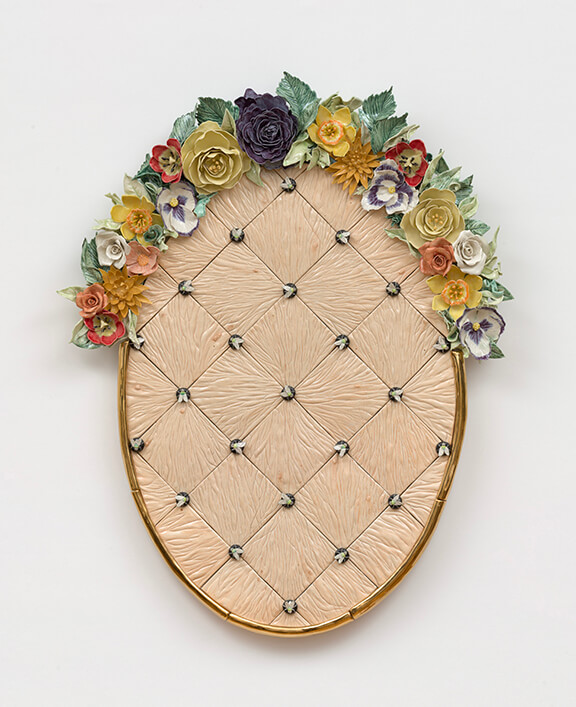Jessica Stoller: Porcelain Power And Deconstructing Feminism

Jessica Stoller redefines feminism in her work, playing on both the grotesque and the surreal within her practice. She uses her ceramic sculpture to explore and subvert idealist forms of beauty. Her work encourages the viewer to question cultural notions surrounding body image, gender, and femininity. Stoller was born in Detroit, Michigan in 1981. She received her BFA at the College for Creative Studies (2004) and her MFA at the Cranbrook Academy of Art, Michigan, (2006). Stoller’s work has been featured in publications such as The New York Times and The Guardian, among others. Solo shows have been mounted at P.P.O.W, (New York) and The Clay Studio (Philadelphia). Group exhibitions have been shown at the Foundation Bernardaud (France) and the Zuckerman Museum of Art, Kennesaw (Georgia).
FRONTRUNNER spoke to Stoller about the corporeal premise of her art, covering her use of medium, subject matter, and plans for upcoming works.

Bloom (2019)
Porcelain, glaze, china paint
16″ x 60″
Courtesy of the artist and P.P.O.W. (New York)
What role, if any, does surrealism play in your practice? Do you identify with a long tradition of surrealist imagery? If so, are there any specific examples?
There are many surrealists whom I find inspiration from but I think Leonor Fini and Méret Oppenheim loom particularly large for me – both combined a feminist wit to their respective practices, which challenged predominant surrealist modes, especially in the depiction of the female form. Fini was interested in exploring myth and sexuality in her work, hybridity took center stage and gender became performative. With Oppenheim, I find her play with materials and her clever eye combing said materials so compelling. Both artists also focused on what lies beneath the skin, whether metaphorical or anatomical. Oppenheim embroidered leather gloves with delicate veins and arteries and Fini populated many of her paintings with flayed or skeletal bodies. Similarly my work is also interested in investigating ideas of gender, material, corporeality, and power. I connect to these two artists in particular but also find endless inspiration from art history and ceramics history at large. In terms of other art movements I would say the Pattern and Decoration of the 70’s & 80’s is formative in its unabashed focus on reinstating ornamentation and craft as central subject matter. I think about how we often “feminize” a material and then devalue it, much like the P& D movement I choose to focus on excess, ornamentation and what has historically been “othered” as content in my work.
Would you say that the “male gaze” is a concern for you? Or is it just the female body and exploring femininity solely?
I think about the “male gaze” in terms of western art history and how that objectified lense has conditioned women to think more about our bodies from the outside looking in. I think of myself as exploring what a “female gaze ” is, but also I don’t want to conform to a gender binary, so really what my own gaze is – creating work from this vantage point. Making what I want to see in the world, maybe that’s a delicate ceramic figure lifting her skirt and flashing a wrinkled ass, or a pile of frosted drooping breasts atop a cake and dolly. I like to disrupt what is expected of the gendered female body and also the material of clay. By focusing on my own body as a centering point, I think about how it can be a site for oppression, but conversely a site for rebellion and subversion.
Talk me through a day in your studio.
My studio is a work-live space that I share with my partner – it’s ideal for me as I like having everything under one roof. Usually I cycle through modes, either I’m doing wet work or china painting pieces, making sure I have enough work to fill the kiln. I love having my cats around and getting lost in my work. A productive day is when the hours just fly by. I am also a big fan of audio books and try to cast a wide net to keep my brain simulated on different ideas that can factor into my work.
Tell me about Bloom.
I was thinking about the history of porcelain flowers from Chinese ceramics to Madame Pompadour’s collection of life like Sèvres flowers adorning her room. Flowers tap into so much symbolism, life and death through exquisite sexual display. The starting point was an orchid-like biomorphic form that I created – it combined rolling flesh with a large splayed flower. I liked the strange tension that resulted and began creating more floral forms in a similar vein. Over time the piece focused on gradiating color from warm reds to cool blues, a sort of anarchic, floral-life cycle. Real and imagined flowers commingle around body parts that were both decaying and sprouting up from the display. I think about the body and our relationship to nature, we are always trying to separate ourselves and think of our bodies as closed and contained when in fact we are very porous and inevitably linked with the earth and our surroundings, for good or bad.

Untitled (embrace), (2021)
Porcelain, glaze, china paint
11″ x 9″ x 14″
Courtesy of the artist and P.P.O.W. (New York)
Your work juxtaposes the “grotesque” with an idealised feminine form. Why is that contrast appealing or important to you?
I think of the “grotesque” in terms of art history which takes its name from the Italian “grottesca “ which harkens back to Nero’s unfinished palace that housed rooms or caves decorated in the “grotesque” style – a form of decorative art containing hybrid imagery that combined animals, plants, and humans in resplendent complexity. The grotesque encapsulates hybridity, metamorphosis, incongruity and humor. I think a lot about the “idealized” body in art history – a form that is often removed from nature, static and contained – for me my own body connects more to the grotesque, a marvelously contradictory leaky container constantly in flux. I see cultural expectations as more the ideal so to my mind it makes sense to have the two impulses in contrast and dialogue with each other.
Can you explain the value of using porcelain in your work?
I’m very interested in the history of porcelain, specifically Europe’s obsession of Asian porcelain and its inevitable links to desire, taste and consumption. With that weighted history, the material becomes an ideal vehicle to investigate my interests in the body and notions of taste, power,and gender. I try to subvert the viewers’ preconceived notions – can a porcelain pimple or stretch mark rendered in subtle hue captivate the same way a delicate strand of pearls can? I’m very drawn to clay because of the range of surfaces and materials it can emulate, it can be painted to have a visceral fleshiness or be rendered to look hard and metallic. Much of my work shifts between disparate elements – playing up both the fragility and strength of the material and its relationship as a metaphor for the body itself.
How have your own particular motifs developed over time?
The historical, cultural and corporeal ideas around the gendered female body have been a constant for me, and the motifs ebb and flow over time. Often I am using flowers or plants as a recurring form because they can be rendered to evoke so many different feelings. Flesh as well is recurring and I use it in various ways to talk about the body without explicitly always creating a figure. I try to not get too reliant on one motif and push myself to focus on new forms that can express my ideas and help them progress. I think detail, color and excess are recurring threads and people hopefully can connect the dots when seeing the work over time.

Untitled (mirror), (2019)
Porcelain, glaze, china paint, lustre, wood
29″ x 24″ x 3″
Courtesy of the artist and P.P.O.W. (New York)
What kind of new forms or themes have you been exploring recently?
With more recent work, I’ve been focusing on aging and the porousness of the body. Dancing half flesh half skeletal figures have emerged and I have been interested in interior anatomy as well as what lies on the exterior. Another new work is also a mirror-like form that shows graying hair with auburn hair cascading below, the hair becoming a sort of portrait and a metaphor for time and change.
How does your work rebuff societal norms when it comes to body image?
Culturally, we’re taught that gendered female bodies are not allowed to age and must forever be youthful; aging is your enemy and we are in an endless loop of constant infantilization. I think of signs of aging as a gift, markers of experience, and struggle. My work rebuffs norms and ideally challenges the viewers associations and judgments, creating space for a new way of seeing both themselves and the material.
What advice would you give to young, upcoming artists looking to break into the industry?
It’s a career that’s always shifting and evolving, highs and lows are a constant. You must find a financial way to sustain yourself, when you’re doing something that can seem unrealistic and not really valued by others, you have to be a bit delusional in your dedication to yourself and your work. For me at this stage in my career it’s been a lot about community. I’m part of a female artist group, and we meet up, read books, and talk about each other’s work. That dialogue is important because you can pick other people’s brains – talk shop and most importantly get critical and engaged feedback on your work. It’s invaluable. You grow and support each other as careers and life progresses – I feel very lucky to have such a talented peer group. So much of my work is just spending time alone in the studio – having other people that I can let into that process is really grounding.











Responses